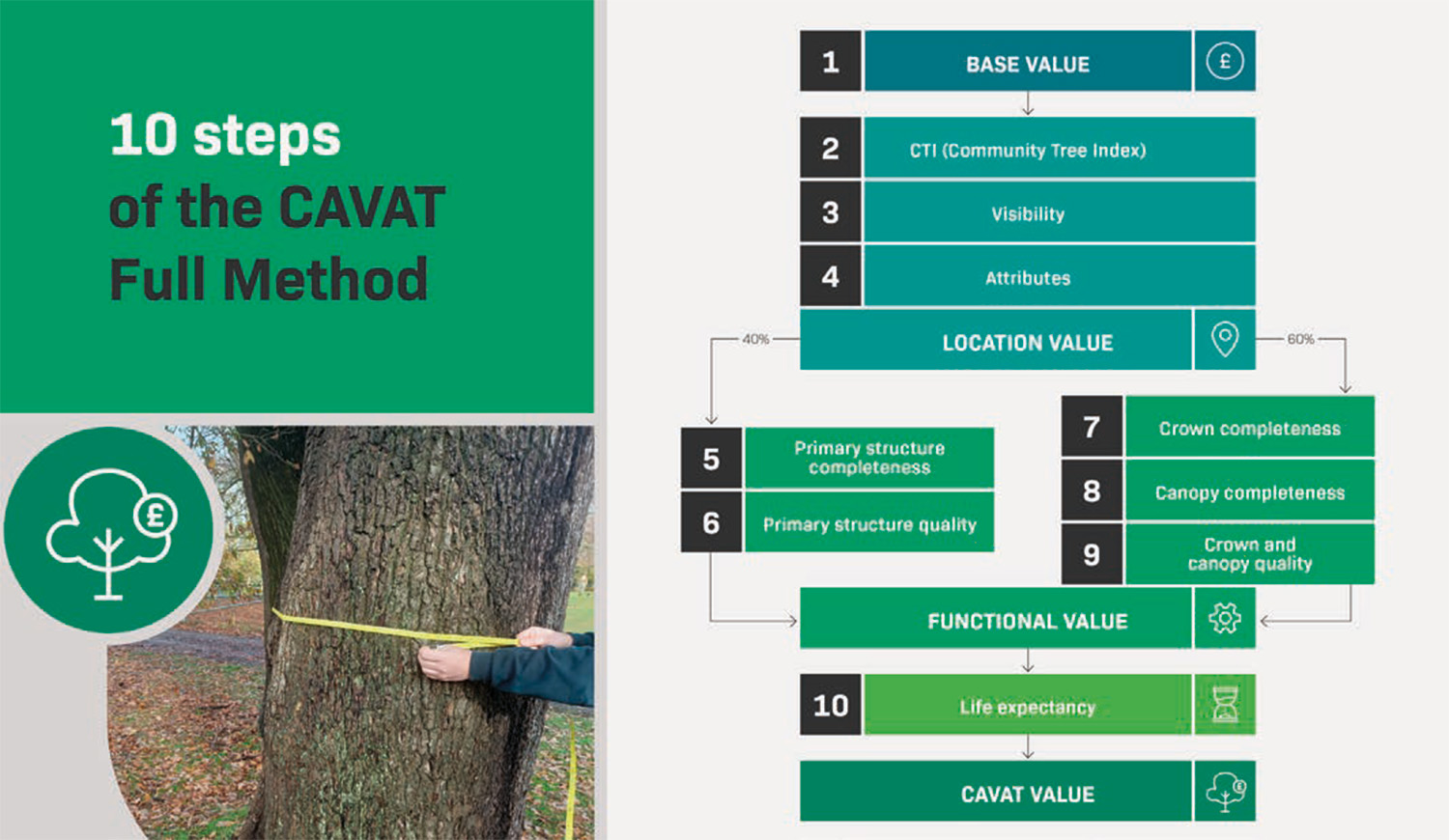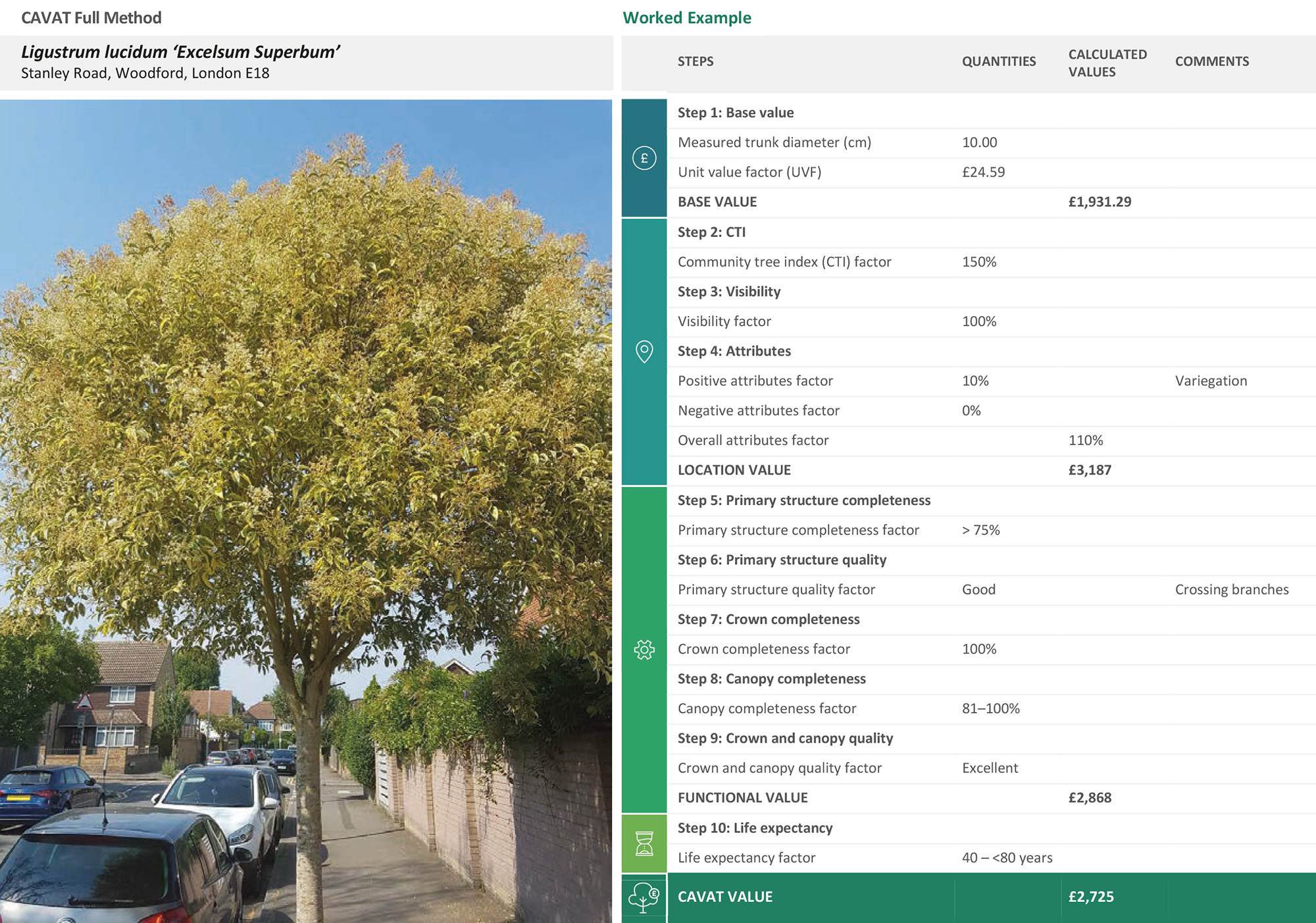Kieron Doick, Andy Allison, Luke Fay, Andy Lederer, Stewart Marshall, Dale Mortimer, Andy Tipping and Hannah Walker
In March this year, the CAVAT Group relaunched the CAVAT (Capital Asset Value for Amenity Trees) Full Method, supported by a new illustrated Guide for Practitioners and a redesigned spreadsheet. This article uses a worked example to give an overview of the 10 steps that comprise the refreshed Full Method. But first, a note on why the change has been necessary and the benefits.
The CAVAT Full Method is one of the global suite of tree valuation tools that use the depreciated replacement cost method. A ‘base value’ is calculated using the Trunk Formula Method in which the cost per unit stem area of an average nursery specimen is multiplied by the trunk area of the tree to be valued to give an initial valuation estimate. This Base value is subsequently appreciated (increased) and depreciated (decreased) to arrive at the final valuation. These adjustments are required as, in extrapolating from nursery prices, it is assumed that the tree being valued has grown to the full potential for the species or cultivar and that the tree is in optimum condition.
Yet a tree that is diseased, reduced, or damaged cannot reasonably be expected to have equal value to one of optimum quality. CAVAT – like all depreciated replacement cost methods – seeks to adjust value for such imperfections. Experience showed, however, that the former two-step consideration of crown quality and completeness, with both subjective and objective considerations, left some trees undervalued, such as pollards, and ancient and veteran trees. It is for these cases that Chris Neilan and the CAVAT Group sought to advance the methodology, whilst not undermining its ease and effectiveness of use for all trees.
The 10 steps of the CAVAT Full Method
The revised Full Method is now a 10-step process (Fig. 1). These steps are grouped in four stages that determine, in series, the Base value (Step 1), the Location value (Steps 2–4), the Functional value (Steps 5–9), and the CAVAT value (Step 10). For completeness, it is also worth stating that the four stages reflect the key elements of a depreciation cost method valuation, namely: Base value (Step 1), adjustment (Steps 2–4), and depreciation (Steps 5–10). The steps are summarised below, following a worked example of a variegated Chinese privet (Ligustrum lucidum ‘Excelsum Superbum’) in Woodford, Greater London (Fig. 2).
Step 1 Base value:
With a stem diameter measurement of 10 cm at 1.5 m height and using the current (2023–24) unit value factor of £24.59, this small decorative street tree in London has a Base value of £1,931.29.
Step 2 Community Tree Index (CTI) adjustment:
This step considers how large the community is that experiences the amenity provided by the example tree. CAVAT considers a tree’s contribution to public amenity and Step 2 is the first part of adjusting value according to the tree’s location. Reference to the CTI Table contained with the CAVAT spreadsheet indicates that Woodford in the London Borough of Redbridge has a CTI factor of 150%.

Figure 1: Flow chart of the CAVAT Full Method’s 10 steps.

Figure 2: Variegated Chinese privet worked example sheet.
Step 3 Visibility adjustment:
This step assesses the tree’s public visibility, as a further measure of its contribution to public amenity. All trees contribute to public amenity, which comprises both visual and non-visual amenity. Trees that make the greatest contribution are those that may readily be seen and appreciated. Being a street tree in an open setting, fully visible to the public, the tree is awarded a visibility factor of 100% (i.e., there is no depreciation to be applied).
Step 4 Attributes adjustment:
With reference to the Attributes table in the Guide for Practitioners, this step accounts for natural and acquired attributes of the tree and their impact on its setting. Only those attributes that make a significant difference to a tree’s contribution to public amenity are considered. Here the notably attractive variegated foliage significantly contributes to the setting and increased public amenity and leads to a 10% increase in value.
The combined adjustment factors from Steps 2–4 result in a Location value for our example tree of £3,187.
The Location value is next adjusted via parallel streams for ‘primary structure’ and ‘crown and canopy’ (Fig. 1). For both streams, the practitioner considers first quantity, and then quality: namely, what is there, and then the quality of what is there.
Step 5 Primary structure completeness assessment:
This step accounts for the completeness of the primary structure. Within the CAVAT Full Method, primary structure is defined as the supporting framework: the trunk, weight-bearing stems, and branches to the point where they begin to divide. CAVAT recognises that a tree’s stem and inner branches are more than a supporting framework for the crown. They contribute substantially to a tree’s visual amenity, particularly in winter as an architectural element of the landscape. The completeness of the primary structure of the example tree was assessed in situ to be >75% complete and the appropriate band was selected from the drop-down menu in the CAVAT spreadsheet. For this level of completeness, 100% of the value is retained.
Step 6 Primary structure quality assessment:
This step adjusts the value to account for the quality of the primary structure, which contributes to the amenity provided by the tree. The quality of the primary structure of the example tree was assessed in situ. The presence of crossing branches reduces quality, which was therefore assessed as ‘Good’, leading to a 25% reduction in value.
Step 7 Crown completeness assessment:
This step adjusts the value to account for the completeness of the crown, relative to what we would expect for an optimum specimen of the same species and stem diameter. A CAVAT valuation acknowledges that an incomplete crown reduces a tree’s contribution to amenity and that this compromises its value. The crown of the example tree was assessed in situ as complete, having had no radial reductions or significant voids caused by, for example, loss of a limb. With no reductions to consider, the crown-volume calculator within the CAVAT spreadsheet is not needed for our example tree, and a crown completeness factor of 100% is selected from the drop-down menu in the CAVAT spreadsheet. 100% of the value is retained.
Step 8 Canopy completeness assessment:
This step adjusts the value to account for the completeness of the canopy, compared to what we would expect the existing crown to support and considering the species and season. Where a canopy is incomplete it reduces the tree’s contribution to amenity and therefore compromises its value. Our example tree is judged to have a full canopy and the canopy completeness factor of 81–100% is selected in the CAVAT spreadsheet. 100% of the value is retained.
Step 9 Crown and canopy quality assessment:
This step considers the quality of the existing crown and the canopy it supports, judged against what we would expect for an optimum specimen. As for the primary structure and the crown, CAVAT recognises that a lower-quality crown or canopy reduces the tree’s contribution to amenity, compromising its value, and adjusts the value accordingly. An expert in situ assessment of the quality of the crown and its canopy reveals that our example tree is rated ‘Excellent’. The rating is selected in the spreadsheet and 100% of the value is retained.
Combining the respective functionality adjustments results in a Functional value for our example tree of £2,868.
Step 10 Life expectancy adjustment:
CAVAT is a depreciated replacement cost approach – it begins with the theoretical cost of a newly planted tree and adjusts for characteristics that depreciate value. One of those characteristics is life expectancy, namely how long it may be reasonably expected to contribute to public amenity considering the typical life span of the species, disease, decay, and the suitability for the location. The example tree was assessed in situ to have a life expectancy of 40 to <80 years. Selecting the appropriate band from the drop-down list in the CAVAT spreadsheet applies the adjustment; 95% of the Functional value is retained.
The resultant CAVAT value for our example tree is £2,725.
CAVAT support
A fully illustrated Guide for Practitioners is available as a free download from the London Tree Officers Association’s (LTOA) CAVAT webpages (www.ltoa.org.uk/resources/cavat). To May 2023, 623 copies have been downloaded since its release at the end of March.
The detailed, step-by-step, document outlines what the practitioner does at each step, how each step works, why the step is part of the valuation, watch points, and photographic examples. A Glossary of Terms and worked examples are also included. An updated survey spreadsheet that includes a Crown Completeness Calculator and a table of Community Tree Index areas are also available as a free download.
In addition, the CAVAT Group has partnered with the Municipal Tree Officers Association (MTOA) to ensure training is available across the UK. To register your interest email enquiries@MTOA.co.uk.
The CAVAT Group
The CAVAT Group is a pro bono initiative which seeks to ensure that CAVAT is an established, defendable system that can be relied upon to inform decisions about amenity trees; to encourage and facilitate CAVAT training; and to promote CAVAT to see it widely adopted as a complementary system for tree professionals, decision makers, planners, and policy makers. The CAVAT Group has representation from LTOA and MTOA, plus representatives from the commercial arboricultural consulting and research sectors.
This article was taken from Issue 202 Autumn 2023 of the ARB Magazine, which is available to view free to members by simply logging in to the website and viewing your profile area.